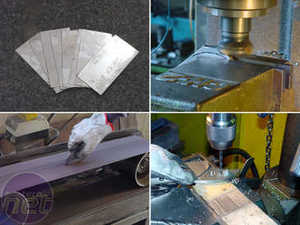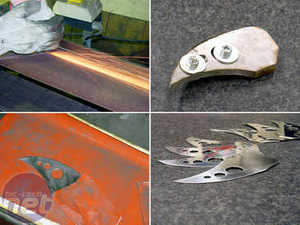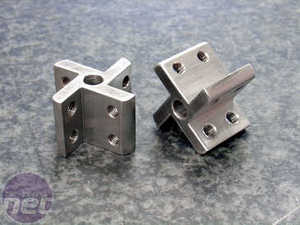The Impellers
After I had successfully tested the tanks and found that they did produce a vortex, it was time to move on to what that vortex would rotate - two large, bladed "impellers," for lack of a better term. I have to say that I was a little surprised at my success - you don't always have your thoughts and plans realised quite so well!There was one very large problem, however - the impeller fins needed to be designed in such a way as to not impede the flow of the water or limit the effectiveness of the cooling system, while being large enough and attractive enough of a design to fit the style of the mod. They also had to be attached in a way that was not intrusive. On top of that, the friction generated by the spinning impeller had to be as low as possible.
The solution to both problems proved to be quite simple and intuitive, though - I created a bronze "tree" that is three millimetres across, which would have a "pin " that fit into the the hole milled in the bottom of each tank. Because the hole for the pin is milled into a "tip" in the centre of each tank bottom, friction would be greatly minimised.
Making the fins
"Powering" the impellers would be the job of four fins, each of which was machined from pressed steel that was a mere 0.8mm thick. I made all eight by hand,without the aid of my CNC machines.To start, I took eight rectangles of the sheet metal and clamped them together in a vice. I then put these against a rotary abrasive bit to begin creating the basic shape. Afterwards, I used a drill press with three different bit sizes to make the three holes. These were secured tightly by the aid of washers and screws before being applied to a belt sander for their final shaping, making eight identical "talons." After a chemical polishing, they were ready for action - and to become the "signature theme" of Dark Blade.
The trees
The "trees" would be where the four fins would connect at 90 degree angles, as well as being the point of contact for the pin assembly. Essentially, these two small pieces would tie together the entire impellers - not a small task!The first phase of the job consisted of milling the basic four-finned shape from a square steel bar by the use of the centre lathe. At that time, a hole was drilled down the centre of the new shape (which was not threaded), making room for the pin assembly. The individual trees were then cut with a saw from the bar, and each fin had two holes drilled in it. Finally, the holes were threaded to accept the hex-bolts which would secure the fins to the tree.

MSI MPG Velox 100R Chassis Review
October 14 2021 | 15:04













Want to comment? Please log in.